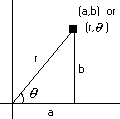

A. Rectangular coordinates are what most people use when graphing coordinates. Given the point (a,b) you move over 'a' spaces on the x-axis, and then up or down 'b' spaces on the y-axis.
B. Polar
Coordinates are the same points as rectangular coordinates, only they are
expressed in terms of 'r' and '![]() '
as the point (r,
'
as the point (r,![]() ).
Here is a picture of the relationship between polar and rectangular coordinates:
).
Here is a picture of the relationship between polar and rectangular coordinates:

As you can
see, r is the hypotenuse and ![]() is
the angle.
is
the angle.
C. Change from Rectangular to Polar:
1. To change from rectangular coordinates you should be familiar with the basic trigonometric properties and also Pythagorean Triples.
2. r = ![]()
3.
![]()
Ex [1] If
(2,2) = (r,![]() ), then
), then ![]() = ______ (degrees)
= ______ (degrees)
a. The answer is tan-1(2/2) or tan-1(1) = 45 degrees.
Ex [2] If
(6,-8) = (r,![]() ), then r =
________
), then r =
________
a. You should know the Pythagorean Triple (6,8,10). The answer is 10.
b. If you
don't know this, then you can see that ![]()
D. Changing from Polar to Rectangular
1. Like above, you need to know basic trigonometric properties.
2. x = r
cos ![]()
3. y = r
sin ![]()
Ex
[1] If (4,![]() )
= (x,y) then y = ______.
)
= (x,y) then y = ______.
a.
The answer is 4sin![]() which
is 4(
which
is 4(![]() ) which is
2
) which is
2![]() .
.
Ex [2] If (6,60o) = (x,y) then x = ______.
a. The answer is 6 cos 60o = 6 x .5 = 3.